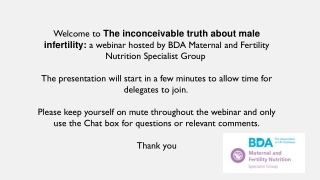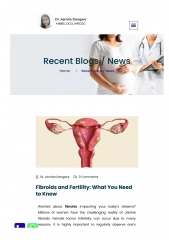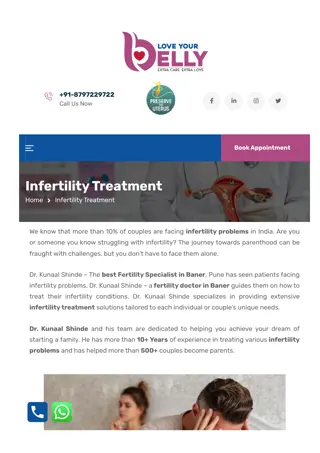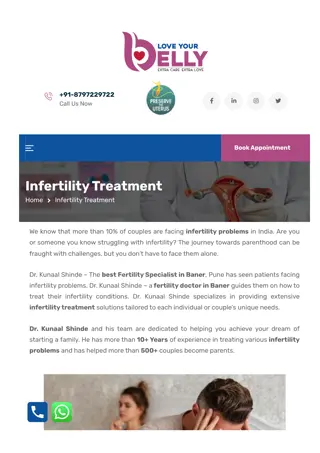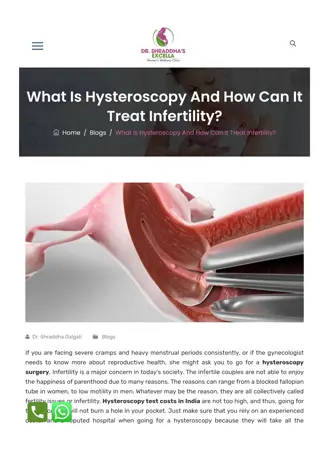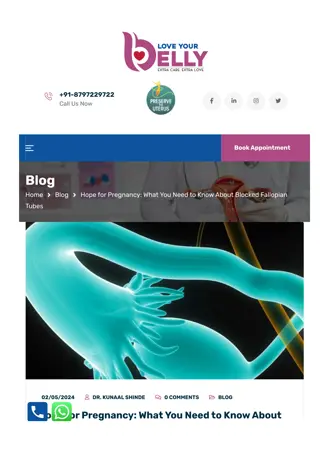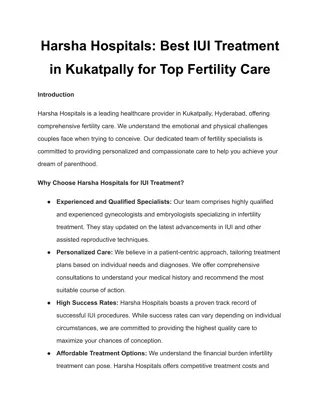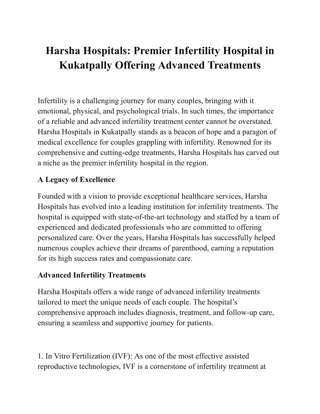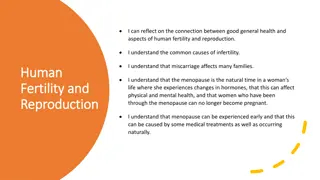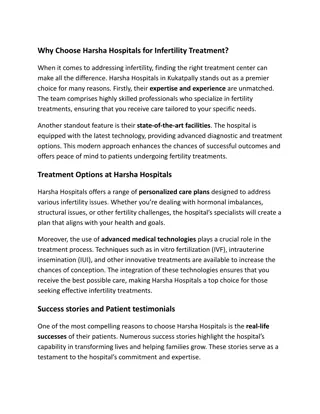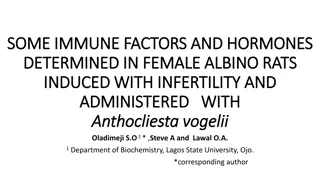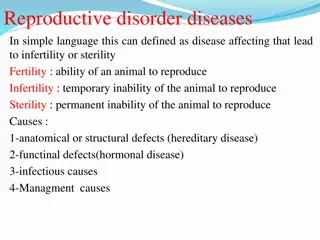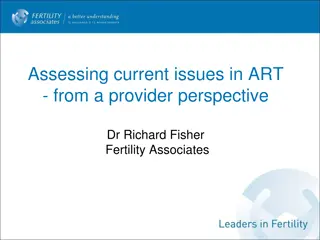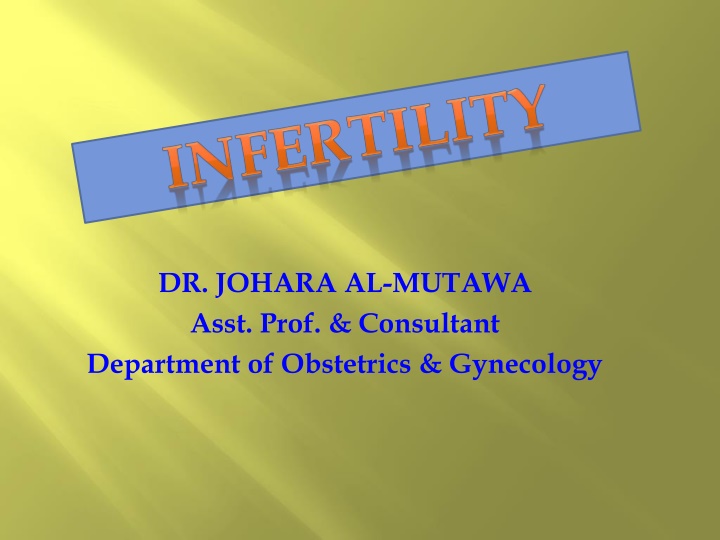
Female Infertility: Causes, Diagnosis, and Treatment Options
Learn about female infertility, including its causes such as ovulatory dysfunction, tubal factors, and endometriosis. Discover the importance of early investigation for infertility, the decline in fertility with age, and common treatments available for subfertility.
Download Presentation

Please find below an Image/Link to download the presentation.
The content on the website is provided AS IS for your information and personal use only. It may not be sold, licensed, or shared on other websites without obtaining consent from the author. If you encounter any issues during the download, it is possible that the publisher has removed the file from their server.
You are allowed to download the files provided on this website for personal or commercial use, subject to the condition that they are used lawfully. All files are the property of their respective owners.
The content on the website is provided AS IS for your information and personal use only. It may not be sold, licensed, or shared on other websites without obtaining consent from the author.
E N D
Presentation Transcript
DR. JOHARA AL-MUTAWA Asst. Prof. & Consultant Department of Obstetrics & Gynecology
Fertility - Subfertility - Sterility Sterility: Absolute and irriversible inability to conceive. Infertility: Diminished capacity to conceive and bear child. Clinically inability to conceive despite regular unprotected sexual intercourse over 12 months Pregnancy rate: 57% 3 months 72% 6 months 85% 12 months 93% 24 months
7% conceive in the second year justifies starting investigation for infertility after one year. Female fertility decline after the age of 35 and decline more rapidly after age of 40. If women 35 years of age, the investigation should be not be delayed. Primary No previous pregnancy Secondary Previous pregnancy whatever the outcome Prevalence: 10 15% 1/3 in the female 1/3 in the male 1/3 in the couple combined
1. Involving each of the major physical events that are necessary to produce a pregnancy. 2. Production of a healthy eggs. 3. Production of a healthy sperm. 4. Transportation of the sperm to the site of fertilization. 5. Transportation of the egg and zygote to the uterus for implantation. 6. Successful implantation in a receptive endometrium 7. Presence of other factors.
CAUSES OF INFERTILY For pregnancy to occur there must be fertile sperm and egg, a means of bringing them together and a receptive endometrium to allow the resulting embryo to implant. A defect at any of these stage can lead to subfertility. Commonest causes in the female: Ovulatory factor Tubal factor Endometriosis Failure of implantation Uterine factor
Failure to ovulate The disorders are grouped into three general categories: Hypothalamus] Pituitary ] Ovarian ] Dysfunction
Anovulatory Infertility Hypergonadotrophic hypogondism failure of the ovary to respond to gonadotrophic stimulation by the pituitary gland result from premature ovarian ovarian failure and exhaustion of the ovarian follicle pool. Resistant ovary syndrome elevated gonadotrophin in the presence of good reserve follicle due to abnormalities of FSH receptors. Hypogonadotrophic hypogonadism Pituitary dysfunction:failure of pitutary gland to produce gonadotrophin will lead to lack of ovarian stmulation due to destruction by; Pituitary tumour adenoma Pituitary inflammation - TB - Ischemia as in Sheehan s Syndrome Pituitary damaged by radiation or surgery Hypotahlamic dynsfuntion: if pulstile secretion of Gn RH is slowed or stops secondary to; Excessive exercise Psycological distress Anorexia nervosa
Ovarian Dysfunction: Polycystic ovary syndrome (PCO) Endocrine disorder: hyperprolactinaemia hypothyroidism Tubal infertility: BID Chlamydia trachomatis Pelvic infection or abscess from appendicitis Septic abortion Pelvic surgery. T.B. Crohn s disease IUCD
Endometriosis Severe form can lead to tubal damage due to adhesion formation caused by endometrial deposit Uterine Factors Submucous fibroid occlude tubes Congenital uterine abnormalities Intrauterine adhesion due to excessive curettage Asherman s syndrome Unexplained infertility Complete of routine investigation fail to reveal cause in 15_30% of cases does not indicate absence of a cause but rather inability to identify it. The result of IVF shown there may be undiagnosed problems of oocytes or embryo qaulity or of implantation failure niether of which can easily be tested unless ivf is undertaken.
Personal & Social History Age female partners Occupation esepcially the male exposure to high temperature Chemical and radiation can affect sperm production Works away from home affect frequency of sexual intercourse around the time of ovulation Smoking - Alcohol
Menstrual History Age of menarche and regularity of periods Irregular menstrual cycle, oligomenorrhia and amenorrhoea are all suggestive of anovulation Amenorrhoea menopausal symptoms Weight loss or gain Symptoms of hyper prolactenimia and hypothyrodism Obstetric History Enquire about previous pregnancies, outcome Breast feeding and any sustained galactorrhoea Dificulties or treatment required prior to achieving a previous pregnancy
Contraception Use of contraception pills and long acting progesterone followed by amenorrhoea Use of long acting progesterone contraception followed by delay in the resumption of ovulation IUCD - risk of infection young nulliparous leading to tubal disease Sexual History Frequency of sexual intercourse Ejaculatory dysfunction Other important points Folic acid Rubella vaccine Family history Diabetes, endometriosis, PCO
Examination Assessment of Body mass index, obesity and under weight cause anovulation Investigation The aim to assess - Ovulation Tubal patency Uterine factors - -
Assessment of Ovulation History of regular period level of progesterone in serum approximately 8 days after LH surge (Mid leuteal phase) BBT Endomettrial histology Cervical mucus LH detection kits Tubal patency tests HSG Laparoscopy and dye test Falloscopy assement of tubal patency and mucosa Ultrasound scan and hydrotubation
Assessment of the uterus -HSG -Hystroscopy TVU with injection of N/S (Hsytrosongraphy) Postcoital test : provides information concerning the ability of the sperm to penetrate and survive in the cervical muscus
Patients with ovarian failure and resistant ovary syndrome will not respond to ovulation induction and they offered oocyte donation . Normalization of body weight in underweight and obese patients can help to regain ovulation without the need for medical intervention. Medical treatment of prolactinoma. Ovulation induction in patients with hypogonadotrophic hypogonadism with pulsatile GnRH or by gonadotophin. Ovulation induction in PCOS patients achieved by weight normalization in obese patients Clomiphene therapy Gonadotrophin therapy Risk of multiple pregnancy & OHSS
management of tubal infertility Can be treated with tubal surgery, IVF and embryo transfer (IVF-ET) or selection salpingography. Although tubal surgery is no longer recommended for severe tubal disease since the introduction of IVF-ET, it still has a place in less severe forms of the disorder.
Management of endometriosis-related infertility Depends on the severity of the condition and the presence of any other infertility factors. The medical methods are inappropriate in an infertile patient either induce anovulation or teratogenicity Conservative surgical treatment of minimal or mild endometriosis may improve natural concption rates postoperayively .Diagnostic laparoscopy and diathermy to endometriosis can be delivered at the same session Sever endometriosis for IVF-ET.
Conservative management, ovulation induction with or without intauterine insemination, and IVE-ET are the main approaches to managing unexplained infertility. It provides information about fertilization and egg and embryo quality. Qwing to its high cost, IVF-ET is usually seen as a last resort in unexplained infertility.
Myomectomy either laparoscopi cally or by laparotomy Entry into the uterine cavty should be avoided if possible, and adhesion barriers and and microsurgical technique to reduce the risk of adhesions Hysteroscopy:Resection of submucous fibroids depending on the size of the fibroid and its degree of protrusion into the uterine cavity Risk of haemorrhage uterine perforation and endometrial scarring leading to intrauerine adhesions
TESTES: 1 - Steroidogenesis Leydig cells between seminiferous tubule Testesterone (LH) 2 Spermatogenesis Sertoli cells (inhibin) (FSH) Both lead to production of healthy spermatozoa. Cryptoorchidism: Infection orchitis mumps Occupation excess heat, radiation, Under GnRH toxic
Lifestyle smoking, alcohol Drugs - Ejaculation disorders Congenital abnormalities Chromosomal anomalies Traumatic causes Coital Abnormalities Vascular Hormonal Inflammatory Immunological Environmental salfasalyasin Retrograde Premature Ejeculation - Impotence
General Health Presence of 20 sexual characteristics Genital Examination Epididymis Testes
Hormonal Chromosome Semen Analysis Volume Liquefa - Density Motility movement Testesterone FSH Karyotype - within 30 min. - 20-250 million/ml - > 50% progressive 2 6ml
Obstructive Non obstructive PRINCIPLE OF MANAGEMENT Deal with the couple together AIM OF INVESTIGATION: To give an explanation of the cause To form basis for treatment. Prognosis
Assisted Conception AIH - ZIFT GIFT IVF ICSI A.R.T IUI

